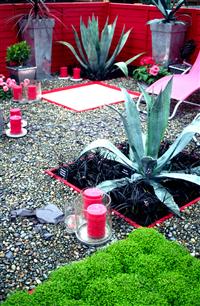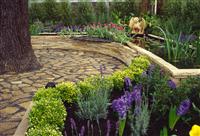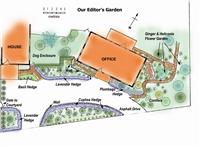LANDSCAPING
The best gardens are created through a fusion of skills and ideas both artistic and practical.
Garden Design incorporates the principles of artistic design with the practicalities of sound construction, and all with a sharp focus on the purpose and ultimate function of a garden.
 Learn more about landscaping from our Principal (John Mason) and our highly skilled team of professionals based in both Australia and the UK.
Learn more about landscaping from our Principal (John Mason) and our highly skilled team of professionals based in both Australia and the UK.
John Mason has designed over 1,000 landscapes (from parks to home gardens), written dozens of books and is the former editor of the magazine "Landscaping Your Backyard", and current editor of Home grown Magazine.
 SEE BELOW
SEE BELOW
- Landscaping Books and Videos
- Distance Education Courses
- Notes on Garden Design (Extract from a course)
- Career Advice
 BOOKS & VIDEOS
BOOKS & VIDEOS
HOW TO START A LANDSCAPE BUSINESS
Order a copy of our principal's book "Starting a Garden or Landscape Business" >>> by clicking here >>>
Landscaping Books in our Bookshop (Click here)
DISTANCE EDUCATION COURSES ON GARDEN DESIGN ACS offer a large range of courses from hobby level through to courses for practicing professionals. Some of the most popular landscaping courses include the following. 
Landscaping I
Landscape Styles
Landscape Construction
Certificate in Horticulture (Landscape and Garden Design)
Water Gardening
Natural Garden Design
Cottage Garden Design
Project Management
Professional Practice for Consultants
See a Sample Lesson below
 Free Articles on Landscaping from our free Garden Ezine (goto www.acsgarden.com )
Free Articles on Landscaping from our free Garden Ezine (goto www.acsgarden.com )
PRINCIPLES OF DESIGN & PLANNING INFORMATION
Every landscape consists of living and non-living components. Examples of non-living components are rocks, paths, walls and garden accessories. The living components of the landscape are the plants (and perhaps the animals that inhabit it). A landscape is made attractive or otherwise by the way in that these components are selected and arranged together.
The landscape is constantly changing, and a good designer must foresee and account for changes that are likely to occur. Plants grow, flower and die. Wooden structures rot and metal ones rust. Earth can erode. The garden continually changes through the cycle of the seasons. A skilled landscape designer will not only be aware of, but will use these changes.
The basic principles of landscape design are those things that influence the way in which the components are used. For example, the overriding principle in Oriental gardens is unity- between rocks, plants and water. For Le Notre, a famous 17th century French designer, a very important principle was that of symmetry, while Capability Brown, an influential 18th century English landscaper, believed the most important principle was for landscapes to be natural in appearance. Ground form, structures and plants all need to be organised into a pleasing composition of spaces to satisfy the principles chosen by the designer. Some of the principles, which can be used, are described below:
- Unity: Unity is achieved by grouping, placing or arranging in such a way that several individual components appear to have a sense of oneness. A desirable appearance needs to be achieved from all points of view. A repetitive pattern can be used to create unity. For example, if you are placing rocks in the garden, use the same type of rock throughout the garden, rather than an assortment of different rocks with varying colours, textures and shapes.
- Balance: This refers to an equilibrium, which can be either symmetrical or asymmetrical. With symmetrical balance there is duplication on either side of an imaginary line of landscape components in terms of line, form or colour - for example, two similarly shaped garden beds in front of a house. Symmetry is an important feature of formal landscapes. Asymmetrical balance involves dissimilar placement of different objects on either side of the same sort of imaginary line, but in a way that equilibrium still exists - for example, three or five silver birch trees planted in a group. Asymmetry gives the garden a more relaxed, natural appearance.
- Proportion: This refers to the sizing or scaling of components in relation to each other and to the total landscape. For example, tall trees are not in proportion if used in a small courtyard, nor is a small shrub in proportion in the middle of a large expanse of lawn.
- Harmony: This refers to the way different parts of the landscape fit together. Overall, most designers strive to achieve a harmonious design, although perhaps not in all parts of the garden.
- Contrast: Contrast is in opposition to harmony and should not be over done. Occasional contrasts are used to create an eye-catching feature in a garden. For example, contrasting foliage texture, colour or form provides a focal point in the garden.
- Rhythm: Rhythm is a conscious repetition of equal or similar components in the garden. It is usually created by repetition and transition (the slow change from one thing to another).
DESIGN ELEMENTS
The components used in a landscape design have a number of characteristics which should be considered. These characteristics are sometimes referred to as design elements:
- Line: Line can be either fixed or moving. Examples of fixed lines are borders of paths, fences, walls, the outline of a building, the shape of a statue and the edge of a lawn. Examples of moving lines are the edge of a shadow and the outline of a fast growing plant.
- Form: Form is the outline or three-dimensional shape of an object.
- Mass: Mass is the degree of solidity of forms. Heavier, denser or darker foliage will create the effect of greater mass.
- Space: Space is the volume which is defined by physical boundaries such as walls, trees, shrubs, ground surface and the sky or canopy of plants above.
- Texture: Texture refers to the patterning of the components of the landscape: coarse or fine, rough or smooth etc. Texture is significant when considering scale, particularly in more intimate, smaller areas. There is texture in plants, wood, stone, gravel ... even in water as the wind blows over its surface.
- Colour: Colour can be used for harmony or contrast. Generally (but not always) designers use contrasting colours sparingly. In general pale or cool colours (white, silver, blue, green and pastel shades) create a relaxing atmosphere in the garden while stronger, more vibrant tones (reds, yellows, orange, bright pink) demand attention and subconsciously encourage activity.
- Tone: Tone is the relationship between colour, light and texture.
SOME DESIGN EFFECTS
- A smooth boundary will make an area seem larger.
- Shadows or openings at one side of an area will make it seem wider.
- Looking downhill makes a distance seem longer.
- Looking uphill makes a distance seem shorter.
- Too much repetition and harmony is monotonous.
- Too much contrast is chaotic.
- Spaces which are too small can be oppressive.
- Large spaces are empty and hollow unless there are a large number of people in those spaces.
- To achieve a harmony in space in enclosed areas the ratio of building height to space width should be no more than 1:4.
- Introduced landforms, such as reshaping of land, should blend in with existing topography.
- Coarse textures decrease the apparent size of spaces.
- Flowing curved lines are passive, soft and pleasant.
- Fine textures will make small spaces look bigger.
- Geometric lines and shapes are solid, strong and formal.
- Sharp, straight irregular lines create an active, vigorous feeling in the garden.
- Close (low) mowing tends to make an area seem larger.
CAREERS IN LANDSCAPING
Landscaping offers a wide range of employment options including:
- Garden Designer
- Landscape Gardener
- Landscape Contractor
- Landscape Architect
- Landscape Consultant
- Landscape Writer
- Teacher/Lecturer
- Various types of specialist trades (eg. Paver, Builder, Plumber, irrigator, excavator etc)
GARDEN DESIGNER
Garden Design is a unique profession that blends science with art.
Designing a garden involves:
- Communicating with the client to determine their needs and desires.
- Surveying the site, and creating a base plan (drawing)
- Determining potentials and limitations (What is and is not feasible)
- Systematically working through a logical design process, to step by step, develop a concept that is physically achievable, as well as being functional and aesthetically appropriate.
You may also be interested in....